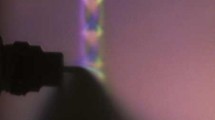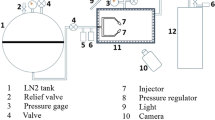Abstract
Liquid film generated by a jet slit injector on a wall was analyzed experimentally. Liquid film characteristics were investigated by measuring the liquid film thickness distribution for various experimental conditions. At first, the distributions were qualitatively analyzed using backlight imaging. Furthermore, quantitative measurements were performed using a liquid film thickness sensor based on the electric conductance method, which was applied to the high-speed wire-mesh method. The injection angle (15, 30, 45 °), jet velocity (7, 10.5, 13.5 m/s), and injection distance (45, 55, 65 mm) were varied, and the responses of the liquid film were observed. Having increased the injection angle, the main stream thickness decreased and the position of the maximum film thickness moved upstream. A faster jet velocity corresponded to a wider liquid film area and larger perturbation of the liquid film. The injection distance did not affect the characteristics of the liquid film considerably. A hydraulic jump effect was also observed, and a large hydraulic jump affected the film thickness distribution of the main stream. The results of this study can be applied to the development of liquid rocket engines or thrusters using the film-cooling method.
















Similar content being viewed by others
Abbreviations
- L l :
-
Liquid cooling film length
- η :
-
Stability effectiveness factor
- \( \dot{m}_{{\text{film}}}\) :
-
Mass flow rate of liquid film
- D ch :
-
Diameter of cylindrical part of combustion chamber
- C pl :
-
Specific heat at constant pressure of liquid coolant
- T s :
-
Boiling point of coolant
- T int :
-
Initial temperature of coolant
- α :
-
Convective heat transfer coefficient
- T gd :
-
Average temperature of combustion product
- T g.ad :
-
Average value of temperature in the section where the liquid coolant exists
- Q s :
-
Relative evaporation heat of liquid film
- θ :
-
Injection angle
- v :
-
Jet velocity
- L :
-
Injection distance
References
Dieter KH, David HH (1992) Modern engineering for design of liquid-propellant rocket engines. Am Inst Aeronaut Astron 10(2514/4):866197
Kim MS, Lee DM (2017) An experimental study of film cooling characteristics at supersonic free stream conditions. J Korean Soc Aeronaut Space Sci 45(4):342–348. https://doi.org/10.5139/JKSAS.2017.45.4.342
Kim SM (2016) Numerical study on the effect of injection nozzle shape on the cooling performance in supersonic film cooling. J Korean Soc Aeronaut Space Sci 44(8):641–648. https://doi.org/10.5139/JKSAS.2016.44.8.641
Son CH, Park IS, Moon YW, Kim HJ, Huh HI (2006) Effects of finite-rate chemistry and film cooling on linear combustion-stability limit in liquid rocket engine. J Korean Soc Aeronaut Space Sci 34(2):75–81
Park SJ, Choi SM, Sohn HS, Cho HH (2013) Effect of secondary flow direction on film cooling effectiveness. Trans KSME (B) 37(7):655–663. https://doi.org/10.3795/KSME-B.2013.37.7.655
Vorobyov AG (2010) Experimental theoretical model of thermal condition of bi-propellant small liquid rocket engine combustion chamber working on continuous mode. Ph.D. Thesis, Moscow Aviation Institute (MAI)
Bogacheva DY Modeling of small rocket engine internal film cooling by gas-phased eological clean propellant components. Ph.D. Thesis, Moscow Aviation Institute (MAI)
Portalski S (1963) Studies of falling liquid film flow film thickness on a smooth vertical plate. Chem Eng Sci 18(12):787–804. https://doi.org/10.1016/0009-2509(63)85046-0
Arnold R, Suslov D, Haidn O (2009) Experimental investigation of film cooling with tangential slot injection in a LOX/CH4 subscale rocket combustion chamber. Trans Japan Soc Aeronaut Space Sci 7:81–86. https://doi.org/10.2322/tstj.7.Pa_81
Vasilev AP, Kudryavtsev VM, Kuznetsov VA, Kurpatenkov VD, Obelnitskii AM (1969) Fundamentals of the theory and calculation of liquid rocket engines. Mach Trans Mono 2:285–588
Chudina Y (2014) Work processes in a small size GOx/GCH4 liquid rocket engine. Ph.D. Thesis, Moscow Aviation Institute (MAI), 2014
Lee HW, Lee HC, Kim TS, Ahn KB, Yoon YB (2018) Optimum design of a liquid film thickness measurement device using electric conductance for impingement liquid film. J Sens Sci Technol 27(6):386–391. https://doi.org/10.5369/JSST.2018.27.6.386
NASA (1977) Liquid rocket engine self-cooled combustion chambers. NASA-SP-8124, 1977
Inamura T, Yanaoka H, Tomoda T (2004) Prediction of mean droplet size of sprays issued from wall impingement injector. Am Inst Aeronaut Astron 42(3):614–621. https://doi.org/10.2514/1.9112
Lightfoot MDA, Schumaker SA, Narayanan V, Eilers B (2011) Injector-wall interactions in gas-centered swirl coaxial injectors. Joint Army Navy NASA Air Force Joint Subcommittee Meeting
Author information
Authors and Affiliations
Corresponding author
Additional information
Publisher’s Note
Springer Nature remains neutral with regard to jurisdictional claims in published maps and institutional affiliations.
Rights and permissions
About this article
Cite this article
Lee, H., Jeong, G., Lee, H. et al. Hydraulic Characteristics of Liquid Film Generated by Slit Injector. Int. J. Aeronaut. Space Sci. 20, 433–441 (2019). https://doi.org/10.1007/s42405-019-00167-4
Received:
Revised:
Accepted:
Published:
Issue Date:
DOI: https://doi.org/10.1007/s42405-019-00167-4




